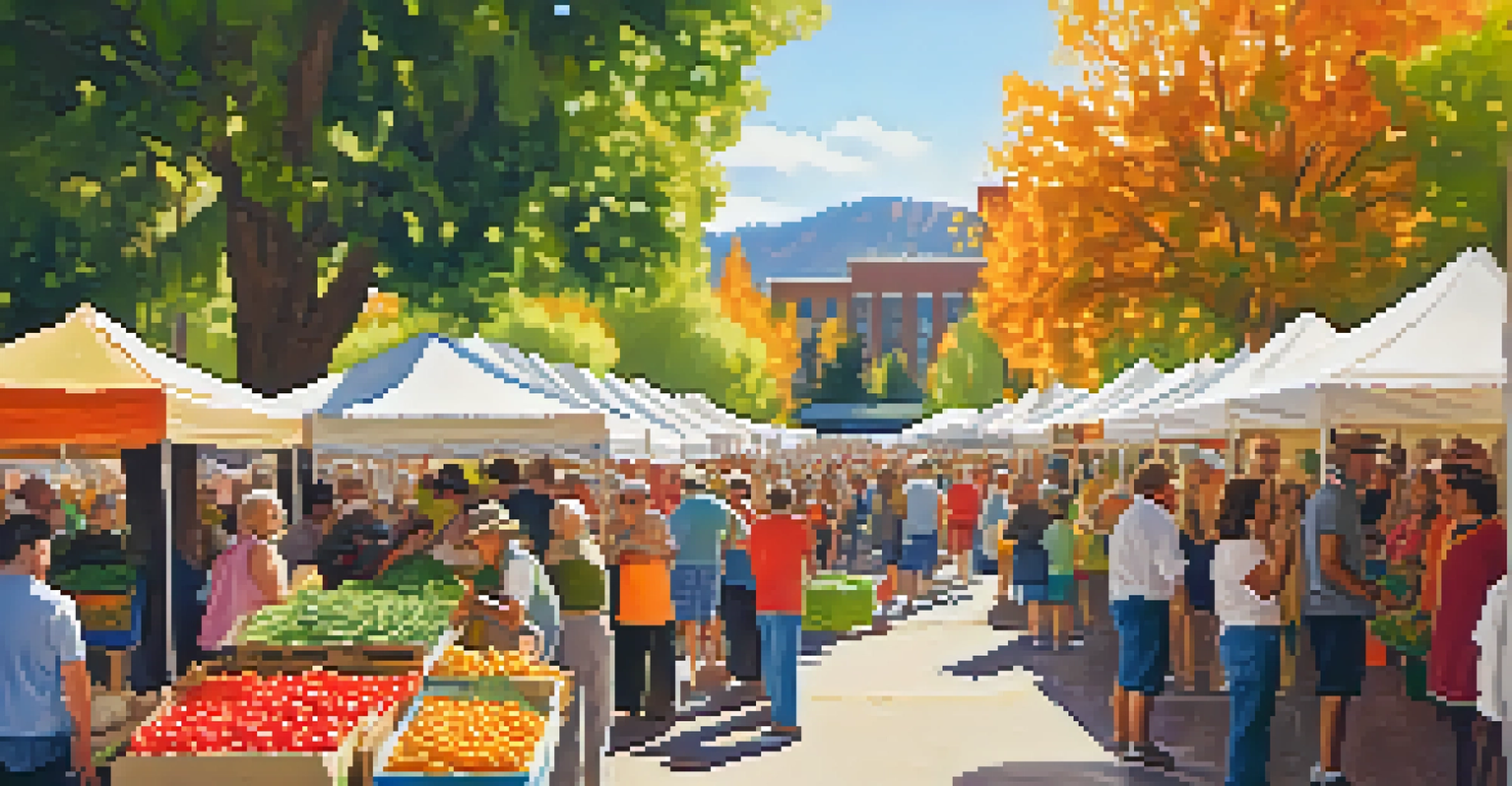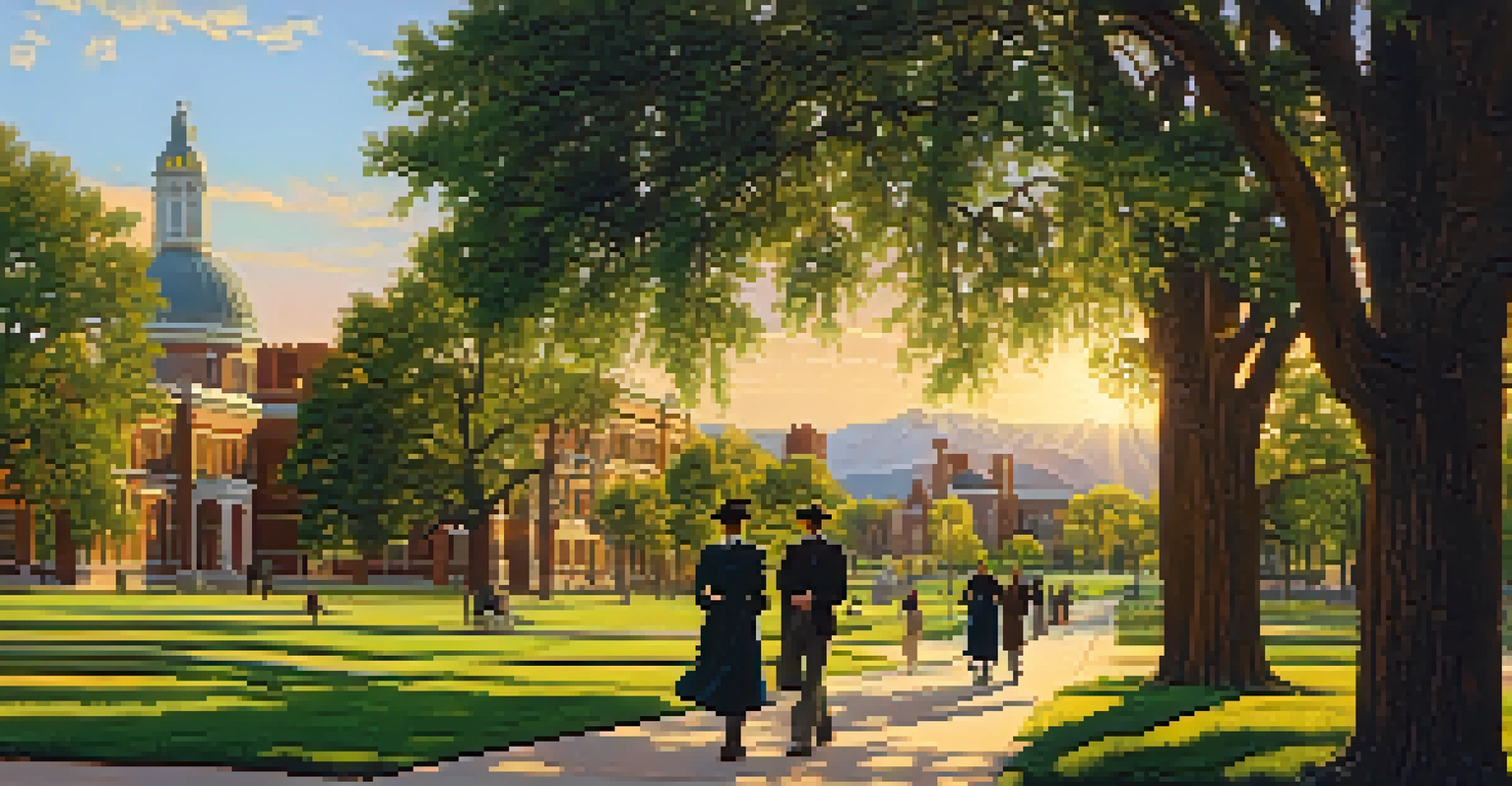Boulder's Development Through the Late 19th Century

The Early Days: Boulder's Founding and Initial Growth
Boulder, Colorado, was founded in 1859 during the gold rush, attracting settlers eager for fortune. The discovery of gold in nearby areas drew people from far and wide, setting the stage for rapid development. As prospectors flocked to the region, they established the town, leading to the first structures and basic infrastructure.
A community is like a ship; everyone ought to be prepared to take the helm.
The initial excitement around gold mining brought a mix of individuals, from hopeful miners to entrepreneurs looking to capitalize on the booming population. This diverse group of settlers laid the groundwork for a vibrant community. Commerce began to flourish, with shops and services springing up to cater to the new residents.
By the late 1860s, the town's population had started to stabilize, transitioning from a mining camp to a more structured community. This shift marked the beginning of Boulder's journey toward becoming a prominent town in Colorado, setting the foundation for its future growth.
Transportation Expansion: Railroads and Accessibility
The arrival of the railroad in the 1870s was a game-changer for Boulder, linking it to larger markets and facilitating trade. The Colorado Central Railroad reached Boulder in 1873, significantly boosting the local economy. This development made it easier for goods to be transported in and out of the town, attracting new businesses and residents.

With improved transportation, Boulder's population began to grow rapidly, as more people were drawn to the area for job opportunities and the promise of a better life. The influx of residents led to an increase in housing construction and the establishment of essential services. It was a pivotal moment that transformed Boulder into a thriving hub.
Boulder's Gold Rush Origins
Boulder's founding in 1859 during the gold rush attracted a diverse population, establishing a vibrant community.
Railroads not only enhanced trade but also made tourism viable. Visitors were now able to explore Boulder's stunning landscapes and natural beauty, setting the stage for the city's future as a tourist destination. This blend of commerce and tourism played a vital role in shaping Boulder's identity.
The Role of Agriculture in Boulder's Economy
As Boulder grew, agriculture became a cornerstone of its economy. The fertile plains surrounding the town offered ideal conditions for farming, leading to the establishment of various agricultural enterprises. Farmers began to cultivate crops like wheat, corn, and sugar beets, which became vital to the local economy.
The environment is where we all meet; where we all have a mutual interest; it is the only thing we all share.
The agricultural boom not only provided food for Boulder's residents but also created jobs and stimulated local businesses. Farmers relied on railroads to transport their produce to urban markets, further integrating Boulder into regional trade networks. This agricultural focus helped diversify the town's economy beyond mining.
Community events, such as harvest festivals, began to emerge, fostering a sense of unity among residents. These gatherings celebrated the agricultural successes and reinforced Boulder's identity as a community deeply connected to its land. The agricultural influence would continue to shape the town well into the future.
Cultural Development: Education and the Arts
Alongside economic growth, Boulder experienced significant cultural development during the late 19th century. The establishment of the University of Colorado in 1876 marked a turning point, attracting students and educators to the area. This institution not only contributed to the local economy but also enriched the community with educational and cultural opportunities.
As the population grew, so did the demand for cultural activities, including art exhibitions and performances. Boulder's residents began to appreciate the arts, paving the way for local artists and musicians to thrive. This cultural awakening contributed to a vibrant community spirit that extended beyond commerce.
Transportation Boosts Growth
The arrival of the railroad in the 1870s transformed Boulder by enhancing trade, tourism, and local job opportunities.
The combination of education and the arts fostered a sense of pride among residents. Boulder's commitment to intellectual and cultural pursuits laid the groundwork for its future as a center of innovation and creativity, attracting like-minded individuals and families.
Social Changes: Immigration and Diversity
Boulder's growth during the late 19th century was accompanied by an influx of immigrants from various backgrounds. These newcomers brought their customs, languages, and traditions, enriching the cultural landscape of the town. As a result, Boulder became more diverse, with a blend of influences shaping its identity.
The arrival of immigrant communities contributed to the labor force, filling jobs in agriculture, construction, and local businesses. This demographic shift allowed Boulder to flourish economically and socially. The interactions between different cultures created a unique atmosphere that defined the town's character.
However, the rapid changes also led to challenges, including tensions between different groups. Despite these struggles, the community began to find ways to celebrate its diversity, ultimately fostering a sense of unity. Boulder's ability to adapt and embrace its multicultural fabric played a significant role in its development.
Environmental Awareness: The Birth of Conservation
As Boulder developed, residents began to recognize the importance of their natural surroundings. The town's stunning landscapes, including the Flatirons and nearby foothills, inspired a growing awareness of environmental conservation. This early appreciation for nature set the stage for future preservation efforts.
In the late 1800s, local advocates began to push for the protection of Boulder's natural resources. They understood that the area’s beauty was not just an economic asset but also a vital part of the community's identity. This awareness led to initiatives aimed at preserving open spaces and promoting sustainable practices.
Cultural and Environmental Awareness
Boulder's growth spurred cultural development and a commitment to environmental conservation, shaping its unique identity.
Boulder's commitment to environmental stewardship laid the groundwork for future conservation efforts. The town's early embrace of nature preservation has continued to resonate today, as residents remain dedicated to maintaining their connection to the environment. This legacy of environmental consciousness continues to shape Boulder's development.
Political Developments: Governance and Community Involvement
As Boulder grew, so did its need for structured governance. The town incorporated in 1871, creating a framework for local government that would address residents' needs. This transition marked a significant step towards self-governance, allowing the community to shape its future.
With a functioning government in place, citizens became more involved in local politics. This engagement fostered a sense of responsibility and ownership among residents, encouraging them to participate in community decisions. Local elections and town meetings became platforms for discussing issues that mattered to Boulder's growth.

The political landscape of Boulder in the late 19th century laid the groundwork for civic engagement that persists today. As residents rallied around shared goals and aspirations, they forged a strong sense of community. This spirit of involvement continues to influence Boulder's identity as a progressive and engaged city.